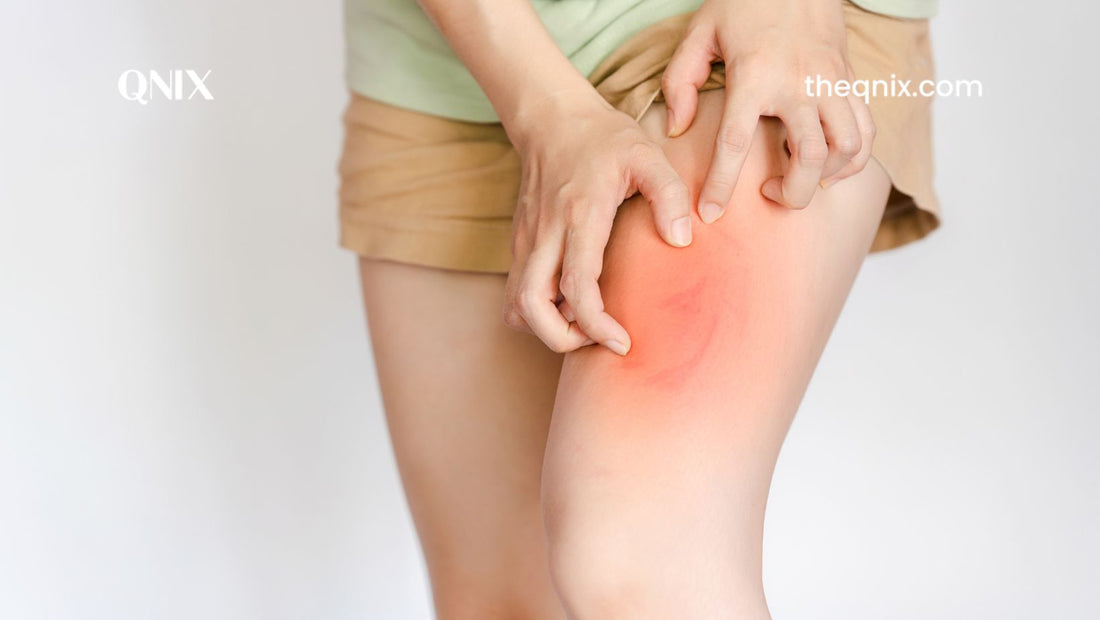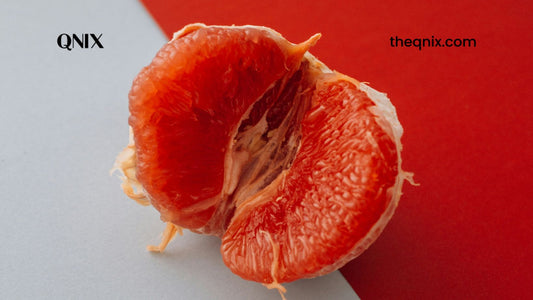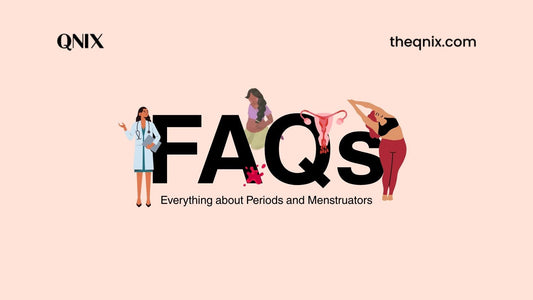Have you ever experienced period cramps that move from your stomach to your back and then, all of a sudden, leave your legs numb and your thighs throbbing?
I have been there, too, and it is the worst. You can't sit, stand, walk, or even lie down peacefully. I wish I could have a hot water bag as long as my legs or be in the hot tub all day, but unfortunately, this can only happen in the Garden of Eden.
So, let us return to the real world of period saga and explore several menstrual leg pain relief techniques that have proven effective for me and, hopefully, will also benefit you
Table of contents
- What Causes Leg Pain During Your Period?
- Identifying Different Types of Leg Pain
- 7 Tips to Reduce Leg Pain During Periods
- Move worry-free with Qnix Period Underwear
What Causes Leg Pain During Your Period?
The release of prostaglandins is one of the main causes of menstrual pain, which can also lead to leg cramps during periods. During menstruation, these hormone-like substances cause uterine contractions that shed the uterus lining.
But why are my legs hurting when my uterus is in my lower abdomen?
This is because increased prostaglandin levels can also stress surrounding muscles, resulting in leg pain and discomfort during the menstrual cycle. Some people may feel heaviness, achiness, or cramping in their legs during periods due to decreased blood flow and circulation to the legs.
Identifying Different Types of Leg Pain
Is it the usual period pain, or is it a sharp or is it making your legs numb?
There are different kinds of leg pain. Let's examine each type and determine how your leg is actually hurting.

1. Cramping Pain: This kind of pain feels like the usual menstrual cramps in the abdomen, with a dull, aching sensation in the thighs or calves.
2. Throbbing pain: Leg pain that feels like it's pulsing in the thighs, calves, or lower legs is known as "throbbing pain" and often occurs due to the changes in hormone levels that impact pain perception, as well as variations in blood flow and circulation.
3. Sharp or Shooting Pain: It is like somebody came out of nowhere and is piercing you with a knife. This kind of pain may be brought on by inflammation, irritation, or nerve compression.
4. Heavy or fatigued legs: Some people may feel as though their legs are heavy, weak, or tired when menstruating. Hormonal fluctuations, decreased blood flow and circulation, or decreased muscle function could cause this feeling.
5. Tingling or Numbness: Tingling or numbness in the legs may indicate nerve irritation or compression. This feeling could be related to pelvic problems or sciatica, and it could happen alone or in combination with other forms of leg pain.
6. Localized Pain: At times, leg pain may be restricted to particular regions, such as the knees, thighs, or calves. Muscle strain, joint inflammation, or pain referred from gynaecological conditions can all cause this kind of discomfort.
Also Read: 7 Drinks to Reduce Period Cramps: Recipes and Special Tips
7 Tips to Reduce Leg Pain During Periods
Managing leg pain during monthly periods can be a hill task. It can make you go insane. So, here are a few tips for reducing leg pain during periods:

1. Stay Hydrated
Drinking water becomes indispensable when it comes to minimizing leg pain and averting muscle cramps. Sufficient hydration is necessary for healthy muscle function and contributes to healthy blood circulation in all body parts, including the legs.
Staying hydrated is essential for lubricating your joints, especially those in your legs. Proper joint lubrication, which helps lessen friction between bones and cartilage, makes smooth and pain-free movement possible.
But how should I keep hydrated when I do not feel like drinking water? Let me simplify it for you.
- Drink your veggies and eat your fruits. Fruits and vegetables are rich in fluids, and they will keep you nourished and hydrated at the same time
- Make a smoothie, and top it with dark chocolate and ice cream. Yummy!
- Make a magical herbal brew with the power of spices.
- I know soups are boring, but sprinkle oregano and chilli flakes and let the flavours melt your taste buds
2. Gentle Exercise and Stretching
Gentle exercise and stretching can be a highly effective natural remedy for leg pain during periods as it improves blood circulation and reduces muscle tension. Engaging in gentle exercise, such as walking, cycling, or swimming, helps promote blood circulation throughout your body, including your legs.
Moving your muscles improves the flow of oxygen and nutrients, eases leg pain and inflammation, and helps your heart pump blood back to your muscles.
Stretching and yoga can be good options during heavy flow days. They relieve tension and stiffness by lengthening and relaxing tense muscles. This can be especially helpful for people who are having leg pain during their menstrual cycle, as it helps counteract the effects of muscle cramps and spasms.
Remember not to overstretch and listen to your body's needs.
Also Read: Vaginal Itching Before Period: Causes, Symptoms & Effective Remedies
3. Heat Therapy
Tense and tight muscles can be relaxed by applying heat to the affected area. Heat widens the skin's blood vessels, boosting local blood flow and supplying the muscles with nutrients and oxygen. This improved circulation eases pain and discomfort by assisting muscles in relaxing and lowering spasms.
Your skin's sensory receptors are stimulated by heat therapy, which may help prevent pain signals from reaching your brain. The sensation of warmth can override the sensation of pain, providing temporary relief from discomfort.
Additionally, heat therapy releases the body's natural pain-relieving hormones and is a holistic approach to leg pain relief during periods. These hormones further reduce pain perception and increase feelings of well-being and relaxation.
Thus, unwind with a long, warm bath with scented candles and relax your mind and body.
Also Read: Period Bloating: A Complete Guide + 5 Quick Relief Tips
4. Massage and Self-Care Techniques
Self-care practices and gentle massage can be extremely beneficial for coping with leg pain during menstruation. Massage promotes relaxation and reduces discomfort by assisting in the release of tension and tightness in the muscles.
Applying light pressure to the muscles with an oil (Peppermint, Ginger, or Chamomile) makes blood flow easier, improving the delivery of nutrients and oxygen to the tissues, diminishing pain, and eliminating spasms.
Research has shown that massage therapy can lower stress hormone levels and increase feelings of relaxation. Effleurage and kneading are two kinds of gentle massage techniques that help calm the nervous system and promote tranquillity.
Whether you choose to use your hands, a massage tool, or other self-care methods, taking time to care for yourself can make a significant difference in how you feel physically and emotionally during menstruation.
5. Magnesium Supplementation
Magnesium is an essential mineral for both muscle contraction and relaxation. It facilitates vascular dilation, or the widening of blood vessels, and helps increase blood flow to muscles and tissues.
Magnesium helps control the body's inflammatory response and has anti-inflammatory qualities.

Taking magnesium supplements or including foods high in magnesium can address magnesium deficiency and relieve leg pain and discomfort during the menstrual cycle.
Following are some ideas for squishing magnesium into your diet:
- Leafy greens: I know most of us hate greens, but mix them with your favourite aaloo ki sabji and add maggi masala, and you will get the magnesium without even tasting the Spinach, kale, Swiss chard, or collard greens.
- Nuts and seeds: Blend Almonds, cashews, pumpkin seeds, and sunflower seeds into your fruit shake and enjoy every sip of magnesium.
- Whole grains: Incorporate Simple ‘Ghar ka Khana,’ which is loaded with whole grains such as brown rice, quinoa, oats, and whole wheat into your meals to boost magnesium intake.’
- Legumes: Add beans, lentils, chickpeas, and peas to your salads, soups, and stews to get that extra protein and magnesium.
- Avocado: Enjoy avocado as a snack, spread, or salad topping to increase your magnesium intake.
- Fatty fish: Salmon, mackerel, and halibut are not only rich in omega-3 fatty acids but also contain magnesium.
- Dark chocolate: Do not fear giving into your cravings for dark chocolate with a high cocoa content (70% or higher) as a delicious magnesium-rich treat.
Do check in with your doctor before starting any new supplement regimen.
Also Read: Feast for Relief: 12 Period-Friendly Foods You Need to Try
6. Elevate Your Legs
Elevating the legs above heart level helps facilitate the drainage of excess fluid, reducing swelling in the legs and feet. Leg elevation can also help promote better blood circulation, especially in the lower limbs, where extended sitting or standing can impair circulation.
Leg elevation encourages fluid to move from the legs back toward the heart, where it can be more effectively circulated and eliminated from the body. Thus, it assists in the fight against fluid retention and, obviously, cramps.
Here is a simple guide to elevate your legs:
- Look for a cosy spot to lie down, such as a yoga mat, couch, or bed. Make sure the surface is comfortable and allows you to extend your legs fully.
- As you lie down, gather cushions or pillows to support your legs. You might need two or more pillows, depending on how tall you want to go. For greater support and stability, use firm pillows or cushions.
- Lay flat on your back and extend your legs. Stretch your legs above your heart by placing the pillows or cushions under your ankles or calves. If necessary, you can even lean on a wall for support.
- After your legs are at a comfortable height, relax and hold this position for as long as you are comfortable. Rest, read, practice meditation, or engage in other calming activities during this time.
- Include leg elevation in your daily regimen, particularly when discomfort and swelling are more noticeable. Try elevating your legs briefly a few times a day to reap the benefits of better circulation and decreased swelling.
- You can even add leg elevation into your daily routine to prevent leg pain during periods.
7. Mind-Body Techniques
Mind-body techniques stimulate the release of endorphins, the body's natural pain-relieving hormones. Endorphins help block pain signals in the brain and promote feelings of well-being and relaxation, which can eventually help reduce leg pain and discomfort.
Muscle stiffness and tension are reduced by deep breathing and relaxation techniques (the best leg pain management technique for menstruating individuals), which promote the relaxation of tense muscles. Progressive muscle relaxation or guided imagery can help you relax your muscles and calm your mind.
By practising mindfulness meditation or other mindfulness-based techniques, you can learn to take your attention off of your pain and discomfort. Focus on here and now and objectively observe your thoughts and sensations.
Practice this affirmation: “I am water. I am flowing through life with ease, grace, and joy.”
Move worry-free with Qnix Period Underwear
I could feel your eyebrows getting tensed when I talked about elevating your legs earlier. I know that feeling of dripping blood sends chills down my spine.
Don't worry. Qnix Period Underwear is at the rescue!
Whether you plan to elevate your legs or stretch them wide, Qnix period underwear gives you the flexibility and peace of mind to relax and unwind. It provides you with end-to-end security and comfort all day long.




